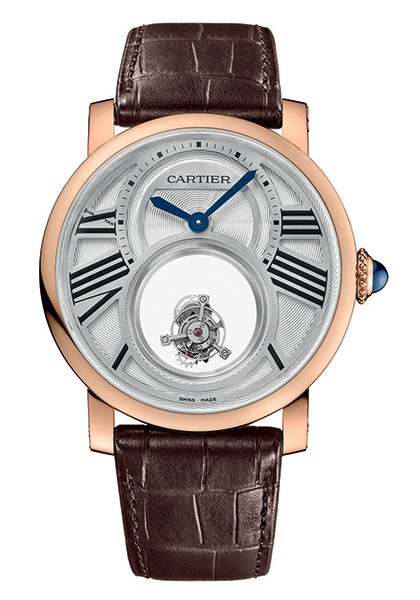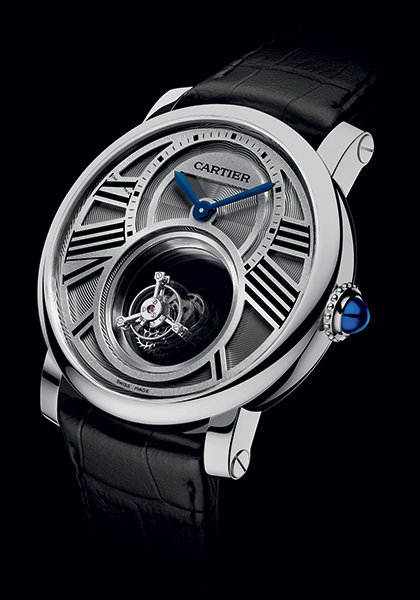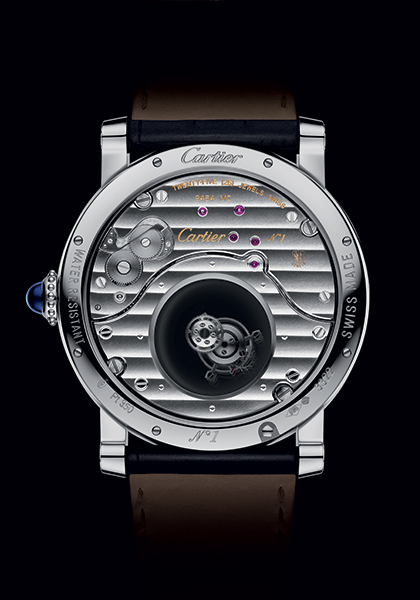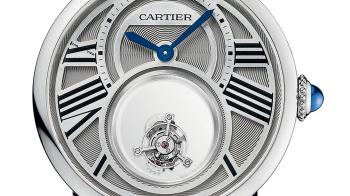Ladies and gentlemen, we present the big top: a Rotonde by Cartier case. The acrobat: a one-minute flying tourbillon within a five-minute tourbillon. The number: rotation around two axes in mid-air. And the trick (because there always is one): the thin air is an optical illusion. What a show!

By 2013, Cartier’s move into fine watchmaking was well-established. Begun five years earlier, focusing mainly on the tourbillon and earning credibility through virtually systematic Geneva Seal certification, it brought the Paris-based brand into the limelight. The Rotonde Double Tourbillon Mystérieux is the meeting-point of two major creative stands: on the one hand, tireless inventiveness, backed by the La Chaux-de-Fonds-based movement manufacture’s technical design department; and on the other, the legacy of mystery clocks. With hands that appeared to be suspended in mid-air, these dainty table clocks created a sensation in the 1910s. In actual fact, the hands were incorporated into rotating rock crystal discs, driven by cogs located on the outer edge. By transferring the concept of a display on transparent discs to the wrist – and including a double tourbillon – Cartier created a watch unlike any other, featuring an acrobatic tourbillon that appears to rotate in thin air.
Layout
This Double Tourbillon Mystérieux comes in a Rotonde case. Simple, round, with a slim bezel and slightly curved sides, this was designed to house Cartier’s most complex movements, most of which are round – something of an exception for a brand better-known for rectangles in all their various proportions. While only 12.4mm thick, at 45mm in diameter the platinum Rotonde is very large indeed, but it has to be. There needs to be room to create a huge gap in the middle, so much so that its hands have been shortened and squeezed up almost to the 12 o’clock position.

The oculus
The 9454 MC calibre was thus put together around a central cavity. Every millimetre of the space around this needed to be used to the full to house the basic parts of a watch: the winding mechanism, barrel, gear train, ratchets, and so on. Around the central void, hidden away between the bridges and the base plate, sit gear trains with internal teeth. These connect the calibre to the regulating organ, a transparent ‘heart’ composed of sapphire discs placed one above the other. These invisible circles actually serve as a tourbillon bridge. This see-through sandwich rotates on its own axis every five minutes, and contains a third disc to which the tourbillon’s organs are fixed; since there is no upper bridge, this constitutes a flying tourbillon.
Space
The visual effect of the Rotonde Double Tourbillon Mystérieux echoes that of the mystery clocks. The impression of floating, suspended in mid-air, is just as compelling on the wrist as photographs suggest, and is further heightened by Cartier’s styling. A huge amount of space is given over to the tourbillon, which takes up fully half of the calibre’s diameter, and there is no sense at all of the cage being confined within cramped quarters – anything but. The Rotonde Double Tourbillon Mystérieux exudes spaciousness; there’s room to breathe. The other, less expected effect is that it is permanently, slightly asymmetrical: while the axis of the standard tourbillon used by Cartier is in the centre of the mechanism, with a concentric cage and balance, the second rotational axis is not. Indeed, the workings of the 9454 MC calibre involve propelling a first, one-minute tourbillon around a central axis – and an orbital trajectory that creates a second, five-minute tourbillon. The principle is similar to that of the ‘teacups’ fairground ride, in which the entire floor of the ride revolves and each cup also spins on its own axis. The five-minute rotation speed has to do with energy-saving considerations. Setting a faster speed would have resulted in better average positions, but used up far more power: an important point bearing in mind that the amount of room available for the barrel is limited by the sapphire oculus.

Lightness
In design terms, the efficiency of this dual rotation is simply a matter of statistics. Like any tourbillon, it increases the frequency with which the balance occupies every position in the plane. Practically speaking, this particular implementation has to avoid the pitfall that threatens so many tourbillons: weight. There’s no point increasing accuracy on the one hand if doing so worsens it elsewhere by creating friction and irregularities due to a given position – the very problem one is trying to avoid in the first place. So Cartier opted for something as light as possible, with a titanium cage weighing just 0.28g, set in sapphire discs with a total weight of 0.56g, including the gears. But that’s all stagecraft. The main thing is that the show goes on.
*This year GMT Magazine and WorldTempus have embarked on the ambitious project of summarising the last 20 years of the Tourbillon in The Millennium Watch Book - Tourbillons, a big, beautifully laid out coffee table book. This article is an extract. The Millennium Watch Book - Tourbillons is available on www.the-watch-book.com, in French and English.





